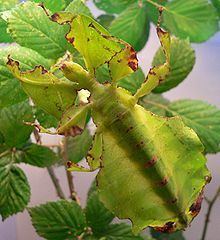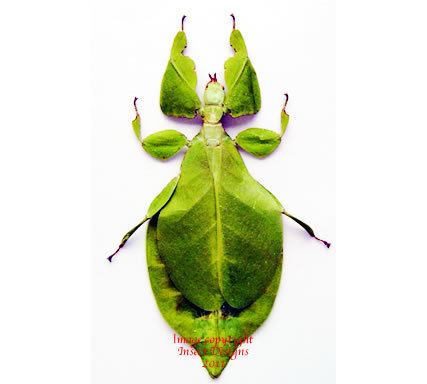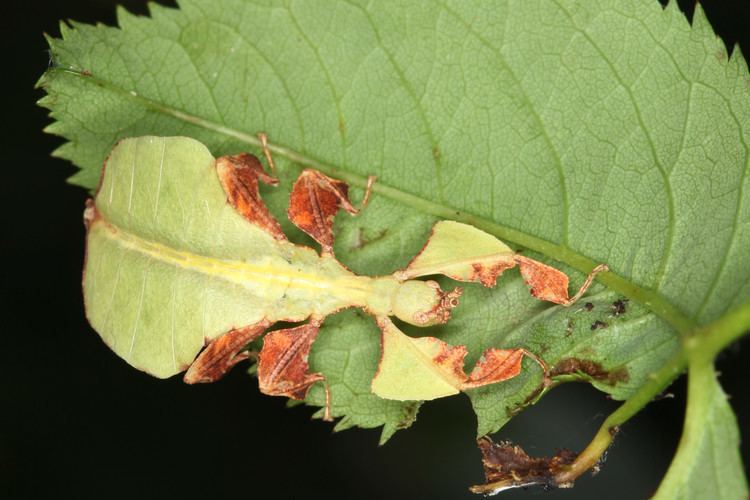Genus Phyllium Rank Species | Scientific name Phyllium bioculatum Higher classification Phyllium Order Phasmids | |
 | ||
Similar Phyllium, Insect, Phasmids, Giant malaysia, Phylliidae | ||
Phyllium bioculatum gray s leaf insect omg scary
The Gray's leaf insect, (Phyllium (Pulchriphyllium) bioculatum), is a leaf insect of the family Phylliidae native to west Malaysia. It was first described by George Robert Gray in 1832, which was his first phasmid he discovered. Leaf insects have extremely flattened, irregularly shaped bodies, wings, and legs. They are usually about 2–4 inches long (5–10 cm) long. They are called leaf insects because their large, leathery forewings have veins that look similar to the veins on the particular type of leaves they inhabit. Its Polish name is liściec dwuoki, which comes from the two dots located on the abdomen just in this species, as does the scientific name (bioculatum meaning "two-eyed").
Contents
- Phyllium bioculatum gray s leaf insect omg scary
- Description
- Ecology
- Habitat
- Diet
- Reproduction and incubation
- References

Description

The insect has green, broad body and legs and frequently has spots. Both females and males occur in shades of green, yellow, and orange. Java leaf insects would be greenish or brownish as adults. Males range from 2.6 to 3.7 inches (66 to 94 mm). The organism's fore wings and camouflage are used for defense. The antennae of the females are very short, while those of the male are longer. Adult females are 1.8–2.7 inches (46–69 mm) in length. The species also has hind wings which are used for flying by males, but are unused by females. Young Phyllium bioculatum are about 2 cm (0.79 in) long, dark red in colour and have reflex immobility. The species molts 5–6 times in a lifetime. Females are heavy-bodied and flightless, and each lays about 500 eggs in a lifetime. The abdomen is narrower at the base, and the femur of the fore legs are dilated.
Ecology

They are slow-moving herbivores and rely on their camouflage and fore wings for defense from predators including birds, amphibians and reptiles. The females live from 4 to 7 months and males from 3 weeks to 1 month.
Habitat
These leaf insects are found mainly in tropical areas and rainforests where adequate quantities of vegetation are available for consumption. It is widespread in Southeast Asia, in Borneo, China, India, Sri Lanka, Java, Malaysia, Singapore, and Sumatra. It is also found in Madagascar, Mauritius, and the Seychelles.
The preferred temperature for this species is 24–28 °C (75–82 °F), which at night may slightly decrease by 2–3 °C (3.6–5.4 °F). Temperature does not strongly affect the species but will slow development. It is important that the temperature is not reduced below 22 °C (72 °F). Low humidity can cause stress and death.
Diet
As a herbivore Phyllium bioculatum mainly eats mango, guava, Nephelium lappaceum (Rambutan), and in captivity some accept Quercus (oak) and Rubus (dewberry, raspberry and blackberry) species.
A study was done in Sri Lanka, based on the leaf insect's diet. The specimens mainly fed on guava. Accordingly, the local name for the species in Sri Lanka is pera kolaya (guava leaf). In many places they are colloquially referred to on the basis of what they eat.
Reproduction and incubation
The females lay eggs in months. Incubation takes place from 5–7 months at 25 °C (77 °F). Eggs are beige-brown and about 6–7 mm (0.2–0.3 in).
However, many times the eggs laid are not fertilized due to parthenogenesis. This is a form of asexual reproduction found in females, where growth and development of embryos occurs without fertilization by a male. Eggs are oval or barrel-shaped, like seeds. Different types of oviposition occurs in leaf insects. The eggs of this species are catapulted by a backward movement of the abdomen. In a study the ratio of the distance the egg was thrown and the bodylength of the insect was compared with some other species, which was 24-36. If the eggs are fertilized, then it takes 3–4 months for incubation, otherwise it takes 6 months for unfertilized eggs. Unfertilized eggs hatch out with females only, while fertilized ones may be either male or female. The female lays about 100 eggs at intervals of a few days. The larvae are red at hatching but green within three to seven days. These hatch from eggs laid at a rate of three per day per female.
